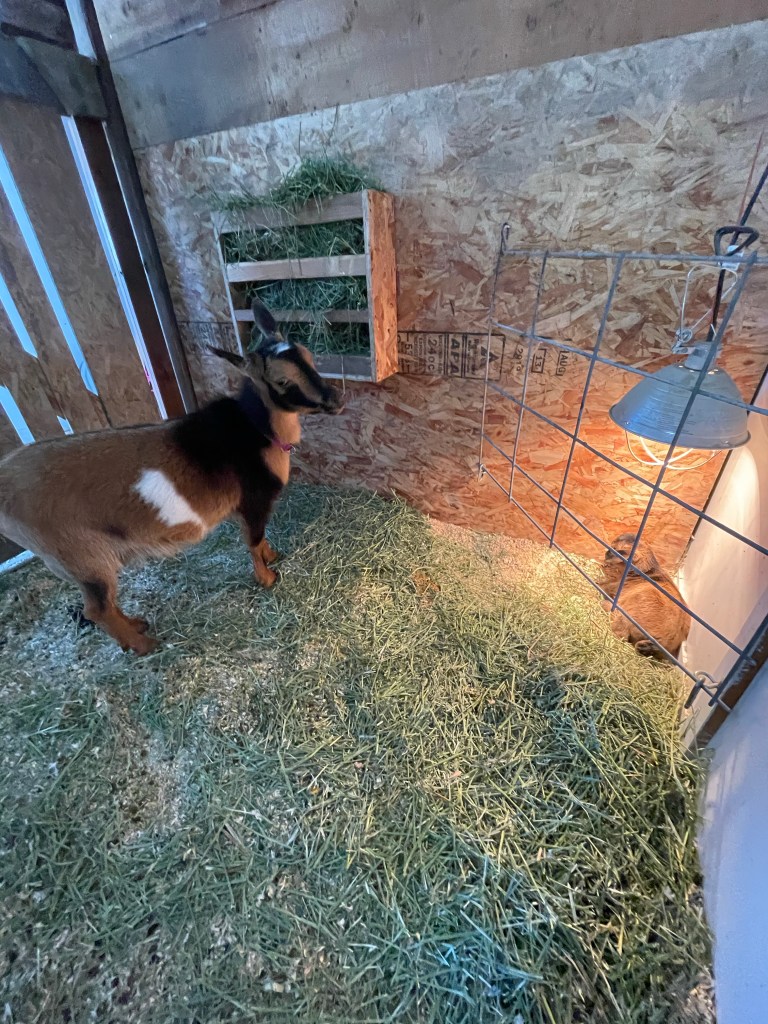Things to know about goats before diving in! Disclaimer: I am not a veterinarian.
Goats need…
Goat care requires…
- Regular hoof care
- Deworming
- Secure fencing
- Clean, dry living area (regular cleaning and maintenance of shelters
Baby goats need…
Goats need hay & water
Farm supply stores sell bags of “goat feed”, but this will not provide goats with the needed fiber for a healthy stomach. They need hay for its long stems that provide fiber for them to regurgitate and chew(goats chew their cud like cows!). Feeding pelleted rations does not satisfy this need and can also cause other problems like acidosis. Goats should never be given free-choice grains, however a handful of grain as a treat or supplement to a hay diet is acceptable. While you can buy hay at feed stores, it may be cheaper to find a local farmer. Only buy good quality hay that appears green inside when a bale is opened. Avoid oat and barley hays unless they have been tested for high nitrates. Grass hay is a great choice, but our favorite is an alfalfa/grass mix.

Fresh water. Goats may not drink water that becomes dirty, so keeping it fresh is important, especially for males to prevent urinary issues. More about feeding goats.
Draft-free shelter
In our north western climate, it’s not unusual to see -30 F degrees in the winter, and then there’s windchill.
These little dairy goats need a dry, draft free shelter to maintain healthy body heat. You don’t want them closed in without ventilation though, because then you may have problems with pneumonia. Three-sided shelters can be acceptable as long as the goats can stay dry and out of the wind. Read more about shelters. Also, watch this video by Marc Warnke about shelters in winter.

Minerals
Many overlook a goat’s need for minerals, but this is non-debatable in my opinion, because I have seen deficiencies and also witnessed improvement from using minerals and supplements in my own herd. Unless your goats are going to free roam over acres and acres of land with plentiful forage containing a diverse population of plants, they will become deficient and start to show health issues, such as weak ankle joints, boughed legs, rough, dull hair coat, hair loss, parasite overloads & anemia to name a few(read more about symptoms).Even goats in a setting as mentioned above can become deficient; it just depends. My goats are in a small field and fed primarily hay. This means I have to supplement their diet with minerals and even sometimes oral gel vitamins and copper bolus pills. My black-colored goats start to turn a rusty brown and tail hairs become sparse. Their coat may feel coarse and wiry instead of soft. Then I know it’s time for their vitamins. More about minerals MINERAL 101.
Other goat friends
Goats are social herd animals. They need each other. Goats have to be with their herd to feel secure and happy. A goat by itself will be much more likely to try escaping and show naughty behavior like jumping onto cars, and constant crying. Sometimes though, they will playfully fight and heat-butt each other, because they have to determine who will be the herd boss. Once they have discovered their place in the herd, they can be at ease until a reason for another challenge arises(treats, feeding time or introducing new herd members). This is normal goat behavior and shouldn’t be of concern unless you find you have a relentless bully.

Hoof care
Goat hooves grow at variable rates, but it’s good to expect to give them a trim at least every two months. It’s not very complicated, and a small pair of sharp pruning shears will do. You should have a stanchion to make this job easier, but you may be able to just tie them to a fence for this job. You may choose to hire this done if there’s someone offering hoof services in your area, though the goats will be much more at ease if you can manage yourself (a stranger can cause anxiety). Read more about hooves here and also more about how to do it yourself here and here. Adding large landscape rocks to your goat pasture for them to climb on may help keep their hooves filed down for less frequent trimmings.
Deworming
Some goats are more prone to parasite problems than others. Your goal overall should be to maintain a healthy herd with adequate nutrition and healthy living conditions and space which will greatly reduce the need for deworming. Worming should not be done on a schedule, because worms can develop immunity to the drugs when they are over-used. You may want to ask a vet’s advice if you suspect a worm problem. Feeding hay in raised feeders above the ground can help with worm prevention. Deworming Chart
how to drench a goat for deworming
Fencing
You may be thinking of letting your goats roam the yard, and for some this may work, but for many the goats become a bit more obtrusive than they expected. They will hop into your car roof, chew on the shirt tails of your guests, eat your shrubs and flowers, peel the bark from your trees and even nibble on house siding. As long as goats are given what they need in their pen or pasture, they shouldn’t be bratty escape artists(Food, water, shelter, other goats and adequate space). We have found cattle panels to be the best fencing option for us, though baby goats can get through it unless you add some welded or woven wire near the bottom. Hog panels would be best but are more expensive. More about fencing here. Fencing your goats in will also protect them from eating poisonous plants or your neighbor’s landscaping which likely won’t be appreciated. Another list of poisonous plants here.
Neighborhood dogs(or your own family dog) can be a threat to your goats, as well as wild predators such as coyotes and cougars. You will need to be sure your goats’ fencing is secure enough so dogs and predators can’t get to them. Since many predators are often most threatening during the nighttime, you may choose to lock your goats into the barn or shelter at night.

Clean, dry environment
Goats can’t be potty trained. They will pee right on their bedding and in their shelter. But to keep them healthy, you’ll have to make sure it stays relatively dry where they spend most of their time. If they sleep in an enclosed barn, make sure there is ventilation to let out moisture and change bedding often enough. Wet living conditions can cause disease and issues like hoof rot, coccidiosis(baby goats are most susceptible to this one), pneumonia, mastitis in does from laying in dirty litter.

Goats are messy. They will jump into hay feeders and stand on the hay and poop. And they will poop right into their water buckets. Investing in a wheel-barrow or dump wagon, a square scoop shovel and rake is a good idea, (a pitchchfork is very helpful too!)because you will need to regularly clean their shelters and wasted hay around feeders to maintain a healthy environment.
Baby goats
If you plan to have does delivering baby goats, you will need to have a draft free barn/shed with a stall for her to give birth on clean bedding and preferably away from other goats. It’s often necessary to have a heat source (premier 1 heat lamps) for newborns if temperatures are freezing. Newborns are very delicate and a heat lamp could be the difference between life or death.

Sometimes a baby goat will get stuck in the birth canal during delivery, and there are a number of situations when it becomes necessary to assist the doe in delivering her baby. If you have a pre-established relationship with your local veterinary, this won’t be too concerning, but for those who can’t find a vet who is willing to come out to the farm for this, you’ll need to educate yourself and be sure you’re ready to handle it. More about assisting birth here.
For healthy baby goats, the most important thing to do is let the mother lick them dry, or if it’s really cold, help dry them with an old bath towel while keeping the baby goat with the mother so she can bond with him. Be sure kids are warm and make sure they suck their mothers colostrum soon(within an hour after birth is best). It’s best to have the new mother and her babies separate so the other goats don’t bother them.
That’s about it…
Please reach out with any questions! Coming soon; Raising bottle babies from birth
Read more Considerations for finding pet goats.
Want to keep learning about goats? Check out my favorite, trusted sources for goat care and education on our resources page.
